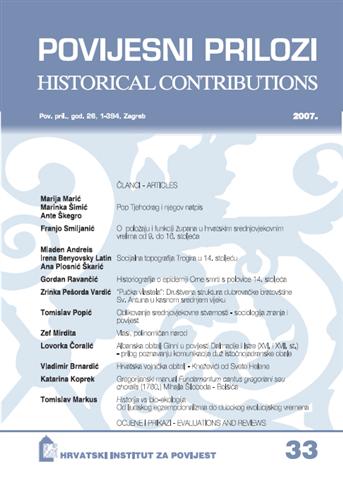O položaju i funkciji župana u hrvatskim srednjovjekovnim vrelima od 9. do 16. stoljeća
Croatian medieval sources on the status and function of župan (iupanus) between the ninth and sixteenth centuries
Author(s): Franjo SmiljanićSubject(s): History
Published by: Hrvatski institut za povijest
Keywords: Middle Ages; Croatia; župan; županija; governing system; territorial rule
Summary/Abstract: The author discusses the development of the notion of župa, as well as of the office of župan from the clan chief, via the royal dignitary, to the official at various levels of government within the territory named in sources as regnum Croatiae, later the Kingdom of Croatia. The sources use terms supannus, iupanus, zupan and špan. The term in use depends on the practice of the chancellery that produced the document. The territory under the jurisdiction of a župan is termed županija. The term župan is semantically related to the term županat, which recognizes the authority that the župan had over the territory under the jurisdiction of a fort. The same term was used to denote duties collected by the bishop in Lika. Trogir sources mention duties collected in the bishop’s županija. There one may find information on the land estates governed by the bishop’s župan. In addition to the royal župan, the available sources point to the existence of another institution: the clan župan, who played a key role in the formation and development of the medieval Croatian state. The oldest documents from the ninth century describe the relationship of župan towards the duke with the expression fideles. This shows that župan served the ruler at his court as well as within the territorial organization of his reign. This is why župan as well as other witnesses present at the signing of these documents are named primates populi. The term designates them as members of clan aristocracy, from among whom the ruler recruits dignitaries to represent his authority. The roots of the institution of župan in the organization of the public rule cannot be considered as a proof for the claim that the only support to the public rule was the clan structure. Any free man could take up this duty. The examined sources have shown that the duties of župan remained unchanged regardless of the type of government in which he performed this role: clan, ducal, royal, church or communal. In time, older duties came to be supplemented with new ones, which depended on the social development. Yet župan remained, in the first place, the steward of the estate, the judge and the person of public faith. His position and his reputation are probably best described by the term gospodin župan (master župan, dominus jupanus), in the community and the person performing a public function. The position of župan could be an honour or a service, depending on the organization of the royal or other public rule. The acquired honour of župan would remain in župan’s possession even after the end of his royal service. In the cases where županija was given in permanent and inheritable ownership, the honour of župan was inheritable too. By contrast, the title of župan earned by serving a lord, church or urban commune was neither permanent nor inheritable. The župans of rural and urban lay confraternities require separate treatment. The institution of the župan as a principal of such c
Journal: Povijesni prilozi
- Issue Year: 2007
- Issue No: 33
- Page Range: 33-102
- Page Count: 69
- Language: Croatian

